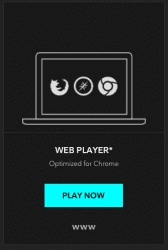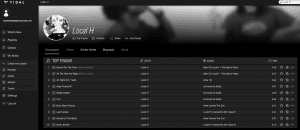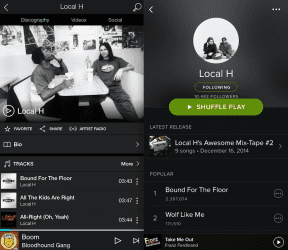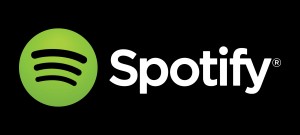Tidal Review: A Day in the Ocean
 If you follow tech and/or music news, you’ve undoubtedly heard about Tidal right now.
If you follow tech and/or music news, you’ve undoubtedly heard about Tidal right now.
Tidal is a music streaming service, similar to Spotify and Rhapsody, that gives users access to millions of songs for a single monthly subscription fee. The service has been around for quite some time but has struggled both from an audience standpoint and a financial one, so much so that it recently sold itself to Jay Z for $56 million, who has now relaunched the service.
That relaunch has seen a surge of publicity for the service and a second life for it. That publicity has hinged on two separate selling points of the service.
First, Tidal, for a fee, provides “lossless” quality music that is supposed to be much higher quality than the “lossy” music streamed on Spotify and even available on most download services. Second, Tidal has the broad support of musicians, many of whom have taken a share into the company and promoted it heavily on social media.
This is in sharp contrast to Spotify, which has frequently found itself in an open war with musicians, most notably Taylor Swift.
Eager to try out Tidal, I snapped up a 30-day free trial shortly after the launch yesterday and decided to give it a spin. The question for me is simple: Is this a service that users will love in addition to artists and can it justify the 2X price point when compared to the competition?
The answer, right now, is a no for me.
The Basics of Tidal
 Tidal is a music streaming service akin to Spotify. This means that your music exists in the cloud and is streamed via the Web to your devices. While you can save playlists and individual albums to your device for offline play, the vast majority of the music in the service is only available with an Internet connection (either land line or cellular).
Tidal is a music streaming service akin to Spotify. This means that your music exists in the cloud and is streamed via the Web to your devices. While you can save playlists and individual albums to your device for offline play, the vast majority of the music in the service is only available with an Internet connection (either land line or cellular).
Currently, Tidal has just two plans. The lower tier is a “lossy” plan that is $9.99 per month and a lossless plan that costs $19.99. Both offer unlimited streaming music, but the lossless version provides access to higher-quality streaming. Spotify, by comparison, has two plans, a free tier that includes advertisements and a $9.99 plan that removes the ads.
Tidal provides three ways to access the service. The first is through a Web player that, according to the site, works in Chrome, Safari and Firefox (though lossless playback is only available in Chrome). It also has apps for iOS and Android that can be downloaded for free from the relevant app stores.
Once again to compare to Spotify, the established service is available on a much wider variety of devices. Not only does Spotify have a Web player that works well in more browsers, but it has standalone apps for Windows, Mac and Linux. It’s also available on iOS, Android, Windows Phone, Blackberry and Kindle products (Kindle products use a separate app store than most Android devices).
Tidal offers access to some 25 million songs compared to Spotify’s 30 million. However, Tidal does have a growing selection of exclusives and also has most of Taylor Swift’s back catalog, though her latest album is not available.
But how is Tidal to use? I fired it up and tried out. I’ve broken apart my findings and thoughts into various sections to help you hone in on what is important to you.
User Experience
 Signing up for Tidal was extremely simple. I opted to use my Facebook account and was set up in just a couple of clicks. The most difficult part was putting my credit card number to activate the free trial.
Signing up for Tidal was extremely simple. I opted to use my Facebook account and was set up in just a couple of clicks. The most difficult part was putting my credit card number to activate the free trial.
However, my first experiences using Tidal were deeply disappointing. My default browser is Safari on OS X and not only was I getting the lossy experience but the entire interface moved sluggishly. Even as other pages and web apps were zipping along, clicks and interactions with Tidal seemed delayed and stilted.
Still, sluggishness aside, Tidal is a very attractive and easy to use web app. Anyone who is familiar with a basic music player or another streaming service will have no trouble picking it up. Everything is intuitive, well put-together and easy on the eyes.
To give it a fair shot, I did try it on Google Chrome and the web app was much more responsive. While I found the need to switch browsers to have it work correctly bit frustrating, if you’re already a Chrome user, likely you’ll be very happy with the performance of the web app.
 After using the web app, I tried out the iOS app. Once again, signing in was easy due to Facebook integration and the app itself was very snappy and usable. As with the web app, everything was laid out very welly and it was easy to find the music I wanted.
After using the web app, I tried out the iOS app. Once again, signing in was easy due to Facebook integration and the app itself was very snappy and usable. As with the web app, everything was laid out very welly and it was easy to find the music I wanted.
The biggest problem I have with the iOS version is that it tries to cram a bit too much information on the screen for my iPhone 6. If you look at a comparison of the same artist page for both Tidal and Spotify (Tidal on left, Spotify on right), you see that Spotify includes less info, but the selections are much larger and easier to press.
Considering one of the most common uses of my mobile music is running and exercise, this is a big deal. Even in Spotify I often click the wrong button and my tests with Tidal showed that it was an even larger problem.
But despite the problems of using Tidal in Safari and the “easier to fat finger” buttons in the iOS app, overall the design was more than serviceable. It could stand a few tweaks (and maybe some more native apps, which are rumored to be in the works) but never got too far in the way of the music experience.
Music Quality and Selection
Having signed up for the higher-tier account, I was eager to see how the music in Tidal would sound. So, after getting in, I immediately pulled up one of my favorite bands, Local H, and began doing side-by-side comparisons between Tidal, Spotify and my downloads.
I tried it both in the web app (using Chrome to ensure lossless quality) and iOS comparing to the Spotify Mac App and Spotify iOS app (at the lowest streaming rate) respectively using my iPhone headphones in every case. After extensively testing Local H tracks I tried out other bands as well including older ones and more modern ones.
While I could detect the difference in some of the songs, it wasn’t a tremendous difference. I would be unlikely to notice if I hadn’t been actively listening to the music with my eyes closed trying to pay attention to the difference. Car noise while driving or street noise while running would have completely eliminated the difference and then some.
I passed along my headphones to other members of my house, playing samples of tracks. Everyone was able to identify which was the higher-quality version, but everyone also said that the difference was very slight and either version was acceptable, especially if it were going to be played in less-than-ideal conditions.
For everyone, this difference faded to nothing when we enabled 320 kb/s streaming in Spotify, which seemingly brought up the quality of Spotify’s stream up to near parity with Tidal.
As for the audio library, the limitations of Tidal’s library hit pretty hard in a few places. In 2012 Metallica made the jump to Spotify but has not made it to Tidal yet. Also, a lot of overseas bands I listen to aren’t Tidal including one of my favorite comedy acts, Kevin Bloody Wilson from Australia, who is also in Spotify.
In short, Tidal’s library is not as large as Spotify’s and nowhere near as large as iTunes and other digital download stores. Whether that matters to you depends on how those holes line up with your tastes. For me, it was annoying, but not necessarily a death blow. I could survive without the missing bands, but some of my playlists would be incomplete, in particular my Christmas comedy ones.
That being said, Spotify does allow you to fill the holes from your private music collection, something Tidal doesn’t, probably because any music from your collection would not be lossless.
This means that any music not in Tidal you will simply have to do without, at least for the time being.
Comparisons Against the Competition
 After using Tidal for a day, it’s easily become my second favorite music streaming service. It’s handily better than others I’ve tried including Sony’s offering, Amazon Prime streaming and Rhapsody. However, I have a very tough time justifying why it is better than Spotify.
After using Tidal for a day, it’s easily become my second favorite music streaming service. It’s handily better than others I’ve tried including Sony’s offering, Amazon Prime streaming and Rhapsody. However, I have a very tough time justifying why it is better than Spotify.
Tidal has a smaller music library, no way to buttress that with your music, no native apps on most platforms and a web app that only works properly in Chrome. The audio quality is better, but only noticeably so in perfect conditions and upping the streaming rate in Spotify all but eliminates the difference.
While Tidal does have some interesting exclusives, none are dealmakers for me. Tidal also has editor-curated playlists but so does Spotify and Spotify throws in a Pandora-like radio mode that aids in music discovery.
Tidal counters this by offering music videos, though it wasn’t a feature I played with much because A) Most of the artists I listen to had no videos and B) VEVO has a much more complete collection available both on its site/app and on YouTube.
While I have no doubt that Tidal is better for the artist, both by eliminating the free tier and offering a higher-end audiophile tier, as someone who is already a paying Spotify customer, I don’t see the benefit of jumping to Tidal right now. This is even more true considering my house is on a family plan that gives us two streams for $15. To even get two low-fidelity streams out of Tidal we would be paying $20, to get the high-fidelity streams it would be $40 per month.
I really want to like Tidal. I like what it stands for and represents, but the music service has to compete with Spotify (and soon Apple) not just by having artist support, but by providing a better product. Tidal’s product competes well, but doesn’t convincingly beat or even tie Spotify as it is right now.
That’s not to say that this can’t change and quickly. Filling out the library, tinkering with the price point, launching native applications for the missing platforms and fixing bugs and UI niggles are all things that they can do over the coming weeks and months.
But even after all of that, Tidal would only have parity with Spotify. While the inclusion of video could give it an edge, if users are going to have to go to other services to find the videos they want anyway, it’s going to be tough to sell as an add on worth paying for, especially as YouTube is entering this market directly.
As I said, I want to like Tidal, I feel that it can be great, but it’s not there yet. While being the vision of the artists is fine, unless it’s also the best deal for the consumers, it’s not going to gain significant traction.
Bottom Line
Spotify built a service that put the music listener first to the point that it angered many artists. Tidal has created a service supported by artists, but doesn’t quite meet consumer needs as well as Spotify, at least not yet.
What I see is two sides trying to dig a tunnel from opposite directions. It is impossible to say who will win this war. However, what worries me is that neither side sees the other as being particularly valuable. Spotify’s treatment of artists is highly derided and Tidal, in their own promotional video (embedded below), view technology as the carrier and separating technology from art.
Here’s the thing. Music is art. But technology is art as well, or at least it can be. A beautiful and effective UI, technology capable of delivering music reliably are creative feats and they can complement music, movies and other media.
For a music streaming service to win, it needs to have both the art of technology and the art of music combined with the art of business.
Right now, no one has the complete picture and we have two very distinct visions of how we are going to get there. Who wins is up for history to decide.
Want to Reuse or Republish this Content?
If you want to feature this article in your site, classroom or elsewhere, just let us know! We usually grant permission within 24 hours.
